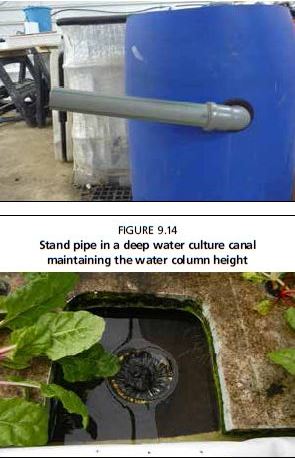9.2 SECURING WATER LEVELS FOR A SMALL-SCALE UNIT
One of the most common disasters for small-scale or commercial aquaponic units is a loss-of-water event where all of the water drains from the unit. This can be catastrophic and kill all of the fish, destroying the system. There are several common ways for this to happen, including electricity cuts, blocked pipes, drains left open, forgetting to add new water or disruption of water flow by animals. All of these issues can be fatal for fish in a matter of hours if problems are not dealt with immediately. Below is a list of methods to prevent some of the above situations.
9.2.1 Float switches
Float switches are inexpensive devices used to control the pump depending on the water level (Figure 9.12). If the water level in the sump tank falls below a certain height, the switch will turn off the pump. This prevents the pump from pumping all of the water out of the tank. Similarly, float switches can be used to fill the aquaponic system with water from a hose or water main. A float switch similar to a toilet ballcock and valve can ensure that the water level never falls below a certain point.
It should be noted that in certain types of loss-of-water events, such as a broken pipe, this method could ensure that the fish survive but actually make the flooding much worse, and it may not be appropriate for indoor applications.

FIGURE 9.12 Float switch controlling a water pump (a) and a ball cock and float valve controlling the water main (b)

FIGURE 9.13 Overflow pipe on a biofilter
FIGURE 9.14 Stand pipe in a deep water culture canal maintaining the water column height
9.2.2 Overflow pipes
Overflow pipes return water from the highest. point in the unit back down to the sump in the event that the normal drainpipes become clogged (Figure 9.13). In these designs, the highest point is the fish tank, but other designs have the grow beds above the fish tank. Regardless, if pipes become blocked, which can occur if plant leaves, media or fish waste accumulate, the overflow pipes can safely drain water back down into the sump. This removes the risk of pumping the water out of the top of the system and draining the tanks.
9.2.3 Standpipes
Standpipes are used in bottom-draining tanks to prevent all of the water from draining out, typically installed in fish tanks. Within the tank in question, a vertical pipe is inserted into the drain (Figure 9.14). This technique defines the height of the water column; water neither gets deeper or shallower than the top of the pipe. However, this solution also means that the water from the bottom of the fish tank is not drained, unless a wider and taller pipe with wide openings at the bottom is positioned to concentrically surround the standpipe. By doing so, the water enters from the bottom and flows upward into the narrow interspace until it pours
out from the standpipe's top. This method is very secure, but requires that the outer pipe is occasionally moved to mobilize the wastes clogged in the interspace between the two pipes.
9.2.4 Animal fences
Opportunistic animals and birds can also cause loss of water by removing, displacing or breaking water pipes in the process of searching for water to drink or fish and vegetables to eat. To prevent this, a simple animal fence can be installed.